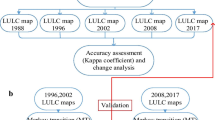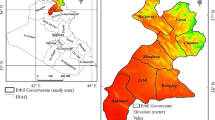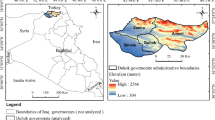Abstract
The detection and prediction of land use/land cover (LULC) change is crucial for guiding land resource management, planning, and sustainable development. In the view of seasonal rhythm and phenological effect, detection and prediction would benefit greatly from LULC maps of the same seasons for different years. However, due to frequent cloudiness contamination, it is difficult to obtain same-season LULC maps when using existing remote sensing images. This study utilized the spatiotemporal data fusion (STF) method to obtain summer Landsat-scale images in Hefei over the past 30 years. The Cellular Automata–Markov model was applied to simulate and predict future LULC maps. The results demonstrate the following: (1) the STF method can generate the same inter-annual interval summer Landsat-scale data for analyzing LULC change; (2) the fused data can improve the LULC detection and prediction accuracy by shortening the inter-annual interval, and also obtain LULC prediction results for a specific year; (3) the areas of cultivated land, water, and vegetation decreased by 33.14%, 2.03%, and 16.36%, respectively, and the area of construction land increased by 200.46% from 1987 to 2032. The urban expansion rate will reach its peak until 2020, and then slow down. The findings provide valuable information for urban planners to achieve sustainable development goals.















Similar content being viewed by others
References
Adami, M., Rudorff, B. F. T., Freitas, R. M., Aguiar, D. A., Sugawara, L. M., & Mello, M. P. (2012). Remote sensing time series to evaluate direct land use change of recent expanded sugarcane crop in Brazil. Sustainability, 4(4), 574–585.
Alhamdan, M. Z., Oduor, P., Flores, A. I., Kotikot, S. M., Mugo, R., & Ababu, J. (2017). Evaluating land cover changes in Eastern and Southern Africa from 2000 to 2010 using validated Landsat and MODIS data. International Journal of Applied Earth Observation and Geoinformation, 62, 8–26.
Alqurashi, A. F., Kumar, L., & Sinha, P. (2016). Urban land cover change modelling using time-series satellite images: a case study of urban growth in five cities of Saudi Arabia. Remote Sensing, 8(10), 838–861.
Ariti, A. T., Vliet, J. V., & Verburg, P. H. (2015). Land-use and land-cover changes in the central rift valley of Ethiopia: assessment of perception and adaptation of stakeholders. Applied Geography, 65, 28–37.
Behera, D. (2007). Mining induced LULC change detection study using Landsat satellite data in Joda-Barbil region of Kenojhar District, Odisha, India. International Journal of Earth Sciences & Engineering, 10(2), 233–241.
Blecic, I., Cecchini, A., & Trunfio, G. A. (2013). Cellular automata simulation of urban dynamics through GPGPU. Journal of Supercomputing, 65(2), 614–629.
Bounoua, L., Nigro, J., Zhang, P., Thome, K., & Lachir, A. (2018). Mapping urbanization in the United States from 2001 to 2011. Applied Geography, 90, 123–133.
Cammalleri, C., Anderson, M. C., Gao, F., Hain, C. R., & Kustas, W. P. (2014). Mapping daily evapotranspiration at field scales over rainfed and irrigated agricultural areas using remote sensing data fusion. Agricultural and Forest Meteorology, 186(10), 1–11.
Chandra, G., Defourny, P., & Surendra, S. (2003). Land cover characterization and mapping of continental Southeast Asia using multi-resolution satellite sensor data. International Journal of Remote Sensing, 24(21), 4181–4196.
Chen, L., Liu, Y., Yihe, L., Feng, X., & Fu, B. (2008). Pattern analysis in landscape ecology: progress, challenges and outlook. Acta Ecologica Sinica, 28(11), 5521–5531.
Chen, L., Sun, R., & Liu, H. (2013a). Research progress of ecological environment effect in the evolution of urban landscape pattern. Acta Ecologica Sinica, 33(4), 1042–1050.
Chen, Y., Li, X., Liu, X., & Ai, B. (2013b). Analyzing land-cover change and corresponding impacts on carbon budget in a fast developing sub-tropical region by integrating MODIS and Landsat TM/ETM+ images. Applied Geography, 45(45), 10–21.
Derya, O. (2015). Urban growth simulation of Atakum (Samsun, Turkey) using Cellular Automata-Markov chain and multi-layer, perceptron-Markov chain models. Remote Sensing, 7(5), 5918–5950.
Dong, T., Liu, J., Qian, B., Zhao, T., Jing, Q., Geng, X., Wang, J., Huffman, T., & Shang, J. (2016). Estimating winter wheat biomass by assimilating leaf area index derived from fusion of landsat-8 and modis data. International Journal of Applied Earth Observation and Geoinformation, 49, 63–74.
Emelyanova, I. V., Mcvicar, T. R., Niel, T. G. V., Li, L. T., & Dijk, A. I. J. M. V. (2013). Assessing the accuracy of blending Landsat–MODIS surface reflectances in two landscapes with contrasting spatial and temporal dynamics: a framework for algorithm selection. Remote Sensing of Environment, 133(12), 193–209.
Fu, P., & Weng, Q. (2016). A time series analysis of urbanization induced land use and land cover change and its impact on land surface temperature with Landsat imagery. Remote Sensing of Environment, 175, 205–214.
Fu, X., Wang, X., & Yang, Y. J. (2018). Deriving suitability factors for CAMarkov land use simulation model based on local historical data. Journal of Environmental Management, 206(15), 10–19
Gao, F., Anderson, M. C., Zhang, X., Yang, Z., Alfieri, J. G., Kustas, W. P., & Prueger, J. H. (2017). Toward mapping crop progress at field scales through fusion of Landsat and MODIS imagery. Remote Sensing of Environment, 188, 9–25.
Gao, F., Masek, J., Schwaller, M., & Hall, F. (2006). On the blending of the Landsat and MODIS surface reflectance: predicting daily Landsat surface reflectance. IEEE Transactions on Geoscience and Remote Sensing, 44(8), 2207–2218.
Gashaw, T., Tulu, T., Argaw, M., & Worqlul, A. W. (2017). Evaluation and prediction of land use/land cover changes in the Andassa watershed, Blue Nile Basin, Ethiopia. Environmental Systems Research, 6(1), 6–17.
Gervais, N., Buyantuev, A., Gao, F., El-Sheimy, N., Lari, Z., & Moussa, A. (2017). Modeling the effects of the urban built-up environment on plant phenology using fused satellite data. Remote Sensing, 9(1), 99.
Gounaridis, D., Chorianopoulos, I., & Koukoulas, S. (2018). Exploring prospective urban growth trends under different economic outlooks and land-use planning scenarios: the Case of Athens. Applied Geography, 90, 134–144.
Guan, D. J., Li, H. F., Inohae, T., Su, W., Nagaie, T., & Hokao, K. (2011). Modeling urban land use change by the integration of cellular automaton and Markov model. Ecological Modelling, 222(20–22), 3761–3772.
Halmy, M. W. A., Gessler, P. E., Hicke, J. A., & Salem, B. B. (2015). Land use/land cover change detection and prediction in the north-western coastal desert of Egypt using Markov-CA. Applied Geography, 63, 101–112.
Huang, C., Chen, Y., Zhang, S., Li, L., Shi, K., & Liu, R. (2016). Surface water mapping from Suomi NPP-VIIRS imagery at 30 m resolution via blending with Landsat data. Remote Sensing, 8(8), 631–645.
Ibrahim, W. Y., & Menzel, W. P. (2014). Agricultural policy effects on land cover and land use over 30 years in Tartous, Syria, as seen in Landsat imagery. Journal of Applied Remote Sensing, 8(1), 319–325.
Jafari, M. (2016). Dynamic simulation of urban expansion through a ca-markov model case study: hyrcanian region, gilan, iran. European Journal of Remote Sensing, 49(1), 513–529.
Kityuttachai, K., Kumar Tripathi, N., Tipdecho, T., et al. (2013). CA-Markov analysis of constrained coastal urban growth modeling: Hua Hin Seaside City, Thailand. Sustainability, 5(4), 1480–1500.
Li, X., Ling, F., Foody, G. M., Ge, Y., Zhang, Y., & Du, Y. (2017). Generating a series of fine spatial and temporal resolution land cover maps by fusing coarse spatial resolution remotely sensed images and fine spatial resolution land cover maps. Remote Sensing of Environment, 196, 293–311.
Liu, D., Zheng, X., Zhang, C., & Wang, H. (2017a). A new temporal–spatial dynamics method of simulating land-use change. Ecological Modelling, 350, 1–10.
Liu, H., & Weng, Q. (2012). Enhancing temporal resolution of satellite imagery for public health studies: a case study of West Nile virus outbreak in Los Angeles in 2007. Remote Sensing of Environment, 117, 57–71.
Liu, N., Budkewitsch, P., & Treitz, P. (2017b). Examining spectral reflectance features related to Arctic percent vegetation cover: implications for hyperspectral remote sensing of arctic tundra. Remote Sensing of Environment, 192, 58–72.
Mas, J. F., Kolb, M., Paegelow, M., Olmedo, M. T. C., & Houet, T. (2014). Inductive pattern-based land use/cover change models: a comparison of four software packages. Environmental Modelling & Software, 51(1), 94–111.
McCarthy, M. J., Radabaugh, K. R., Moyer, R. P., & Muller-Karger, F. E. (2018). Enabling efficient, large-scale high-spatial resolution wetland mapping using satellites. Remote Sensing of Environment, 208, 189–201.
Mizuochi, H., Hiyama, T., Ohta, T., Fujioka, Y., Kambatuku, J. R., & Iijima, M. (2017). Development and evaluation of a lookup-table-based approach to data fusion for seasonal wetlands monitoring: an integrated use of AMSR series, MODIS, and Landsat. Remote Sensing of Environment, 199, 370–388.
Mohammadi, A., Costelloe, J. F., & Ryu, D. (2017). Application of time series of remotely sensed normalized difference water, vegetation and moisture indices in characterizing flood dynamics of large-scale arid zone floodplains. Remote Sensing of Environment, 190, 70–82.
Monseru, R. A., & Leemansb, R. (1992). Comparing global vegetation maps with the Kappa statistic. Ecological Modelling, 62(4), 275–293.
Mosammam, H. M., Nia, J. T., Khani, H., Teymouri, A., & Kazemi, M. (2016). Monitoring land use change and measuring urban sprawl based on its spatial forms: the case of Qom city. Egyptian Journal of Remote Sensing and Space Science, 20, 103–116.
Muller, M. R., & Middleton, J. (1994). A Markov model of land-use change dynamics in the Niagara region, Ontario, Canada. Landscape Ecology, 9(2), 151–157.
Mueller, N., Lewis, A., Roberts, D., Ring, S., Melrose, R., Sixsmith, J., & Ip, A. (2016). Water observations from space: mapping surface water from 25 years of Landsat imagery across Australia. Remote Sensing of Environment, 174, 341–352.
Osgouei, P. E., & Kaya, S. (2017). Analysis of land cover/use changes using Landsat 5 TM data and indices. Environmental Monitoring and Assessment, 189(4), 136.
Pickard, B. R., Berkel, D. V., & Petrasova, A. (2017). Predicts of urbanization scenarios reveal trade-offs between landscape change and ecosystem services. Landscape Ecology, 32(3), 617–634.
Prenzel, B. (2004). Remote sensing-based quantification of land-cover and land-use change for planning. Progress in Planning, 61(4), 281–299.
Saleem, A., Corner, R., & Awange, J. (2018). On the possibility of using corona and landsat data for evaluating and mapping long-term lulc: case study of iraqi kurdistan. Applied Geography, 90, 145–154.
Palmate, S. S., Pandey, A., & Mishra, S. K. (2017). Modelling spatiotemporal land dynamics for a trans-boundary river basin using integrated Cellular Automata and Markov chain approach. Applied Geography, 82, 11–23.
Shen, H., Huang, L., Zhang, L., Wu, P., & Zeng, C. (2016). Long-term and fine-scale satellite monitoring of the urban heat island effect by the fusion of multi-temporal and multi-sensor remote sensed data: a 26-year case study of the city of Wuhan in China. Remote Sensing of Environment, 172, 109–125.
Singh, S. K., Mustak, S., Srivastava, P. K., Szabó, S., & Islam, T. (2015). Predicting spatial and decadal LULC changes through cellular automata Markov chain models using earth observation datasets and geo-information. Environmental Processes, 2(1), 61–78.
Sinha, A. P., Kumar, L., & Reid, N. (2012). Three-date landsat thematic mapper composite in seasonal land-cover change identification in a mid-latitudinal region of diverse climate and land use. Journal of Applied Remote Sensing, 6(1), 3595.
Walsh, S. J., Crawford, T. W., Welsh, W. F., & Crews-Meyer, K. A. (2001). A multiscale analysis of LULC and NDVI variation in Nang Rong district, northeast Thailand. Agriculture Ecosystems & Environment, 85(1), 47–64.
Wang, R., Hou, h., & Murayama, Y. (2018). Scenario-based simulation of Tianjin City using a Cellular Automata–Markov model. Sustainability, 10, 2633. https://doi.org/10.3390/su10082633.
Wu, P., Shen, H., Zhang, L., & Göttsche, F. M. (2015). Integrated fusion of multi-scale polar-orbiting and geostationary satellite observations for the mapping of high spatial and temporal resolution land surface temperature. Remote Sensing of Environment, 156, 169–181.
Xie, D., Gao, F., Sun, L., & Martha, A. (2018). Improving spatial-temporal data fusion by choosing optimal input image pairs. Remote Sensing, 10, 1142. https://doi.org/10.3390/rs10071142.
Zhang, F., Zhu, X., & Liu, D. (2014). Blending MODIS and Landsat images for urban flood mapping. International Journal of Remote Sensing, 35(9): 3237–3253.
Zhu, X. L., Jin, C., Feng, G., Chen, X. H., & Masek, J. G. (2010). An enhanced spatial and temporal adaptive reflectance fusion model for complex heterogeneous regions. Remote Sensing of Environment, 114(11), 2610–2623.
Acknowledgments
We thank the data providers of USGS and the International Scientific & Technical Data Mirror Site, Compute Network Information Center, Chinese Academy of Sciences. We thank Dr. Xiaolin Zhu (The Hong Kong Polytechnic University) for providing access to the ESTARFM IDL code.
Funding
This work was supported in part by the Mining environmental restoration and wetland ecological security Collaborative Innovation Center, the National Natural Science Foundation of China under Grant 41501376.
Author information
Authors and Affiliations
Corresponding author
Additional information
Publisher’s Note
Springer Nature remains neutral with regard to jurisdictional claims in published maps and institutional affiliations.
Rights and permissions
About this article
Cite this article
Lu, Y., Wu, P., Ma, X. et al. Detection and prediction of land use/land cover change using spatiotemporal data fusion and the Cellular Automata–Markov model. Environ Monit Assess 191, 68 (2019). https://doi.org/10.1007/s10661-019-7200-2
Received:
Accepted:
Published:
DOI: https://doi.org/10.1007/s10661-019-7200-2




